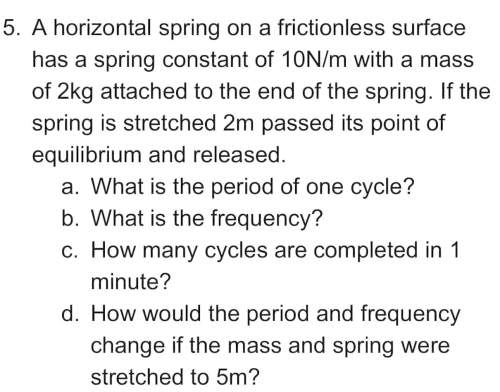
Physics, 19.07.2019 17:00 xarianna2007
Aphoton with wavelength λ = 0.0830 nm is incident on an electron that is initially at rest. if the photon scatters in the backward direction, what is the magnitude of the linear momentum of the electron just after the collision with the photon?

Answers: 1


Other questions on the subject: Physics

Physics, 22.06.2019 00:00, tsupreme
1134567 a jet with mass m = 1.1 ă— 105 kg jet accelerates down the runway for takeoff at 2 m/s2. 1) what is the net horizontal force on the airplane as it accelerates for takeoff? 2.2*10^5 n your submissions: 2.2*10^5 computed value: 220000submitted: saturday, january 26 at 2: 41 pm feedback: correct! 2) what is the net vertical force on the airplane as it accelerates for takeoff? 0 n your submissions: 0 computed value: 0submitted: saturday, january 26 at 2: 41 pm feedback: correct! 3) once off the ground, the plane climbs upward for 20 seconds. during this time, the vertical speed increases from zero to 21 m/s, while the horizontal speed increases from 80 m/s to 95 m/s. what is the net horizontal force on the airplane as it climbs upward? n 4) what is the net vertical force on the airplane as it climbs upward? n 5) after reaching cruising altitude, the plane levels off, keeping the horizontal speed constant, but smoothly reducing the vertical speed to zero, in 13 seconds. what is the net horizontal force on the airplane as it levels off? n 6) what is the net vertical force on the airplane as it levels off?
Answers: 1

Physics, 22.06.2019 00:10, oktacos
The energy released by a chemical reaction can be measured using a calorimeter. when barium hydroxide octahydrate crystals are reacted with dry ammonium chloride inside of a coffee cup calorimeter, the temperature of the 18.00 g of water in the calorimeter decreases from 30.0°c to 8.0°c. the equation for calculating energy absorbed or released by a reaction is: where q is the energy released or absorbed, m is the mass of water in the calorimeter, cp is the specific heat of water, and δt is the observed temperature change. if the specific heat of liquid water is 4.19 j/g·°c, how much energy was absorbed by the reaction?
Answers: 3


Physics, 22.06.2019 16:20, adiafloresp2dkbx
Specific heat refers to the amount of heat required to change 1 gram of a substance by degree(s) celsius
Answers: 1
You know the right answer?
Aphoton with wavelength λ = 0.0830 nm is incident on an electron that is initially at rest. if the p...
Questions in other subjects:

History, 04.02.2021 23:10


Social Studies, 04.02.2021 23:10



Mathematics, 04.02.2021 23:10



Chemistry, 04.02.2021 23:10

Mathematics, 04.02.2021 23:10




